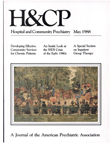The Religious Component of Acute Hospital Treatment
Abstract
A clinically trained chaplain working part time in an acute psychiatric day hospital unit af- fords patients an opportunity to explore the religious dimension of their lives and educates staff about how to address patients' religious beliefs and incorporate them into treatment and discharge planning. The chaplain meets individually with patients at their request, is coleader with a mental health professional of a patients' group that discusses ways of enriching one's life, and participates in clinical team meetings. During the first 12 months of the program, a pastoral consultation was requested by 59 percent of patients who were offered one at admission. About another 10 percent sought consul- tation later or attended the patient group. By incorporating a religious component in acute treatment programs, mental health care facilities can serve the broader purpose of increasing collaboration with religious and other groups in the community and expand the resources available to the patient at discharge.
Access content
To read the fulltext, please use one of the options below to sign in or purchase access.- Personal login
- Institutional Login
- Sign in via OpenAthens
- Register for access
-
Please login/register if you wish to pair your device and check access availability.
Not a subscriber?
PsychiatryOnline subscription options offer access to the DSM-5 library, books, journals, CME, and patient resources. This all-in-one virtual library provides psychiatrists and mental health professionals with key resources for diagnosis, treatment, research, and professional development.
Need more help? PsychiatryOnline Customer Service may be reached by emailing [email protected] or by calling 800-368-5777 (in the U.S.) or 703-907-7322 (outside the U.S.).



